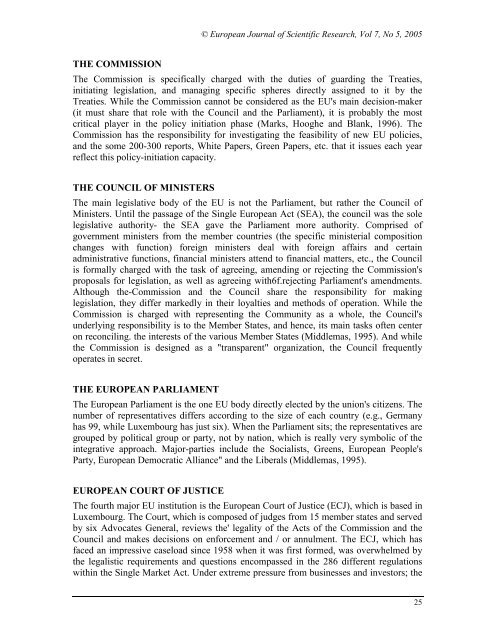European Journal of Scientific Research (ISSN: 1450 ... - EuroJournals
European Journal of Scientific Research (ISSN: 1450 ... - EuroJournals
European Journal of Scientific Research (ISSN: 1450 ... - EuroJournals
Create successful ePaper yourself
Turn your PDF publications into a flip-book with our unique Google optimized e-Paper software.
© <strong>European</strong> <strong>Journal</strong> <strong>of</strong> <strong>Scientific</strong> <strong>Research</strong>, Vol 7, No 5, 2005<br />
THE COMMISSION<br />
The Commission is specifically charged with the duties <strong>of</strong> guarding the Treaties,<br />
initiating legislation, and managing specific spheres directly assigned to it by the<br />
Treaties. While the Commission cannot be considered as the EU's main decision-maker<br />
(it must share that role with the Council and the Parliament), it is probably the most<br />
critical player in the policy initiation phase (Marks, Hooghe and Blank, 1996). The<br />
Commission has the responsibility for investigating the feasibility <strong>of</strong> new EU policies,<br />
and the some 200-300 reports, White Papers, Green Papers, etc. that it issues each year<br />
reflect this policy-initiation capacity.<br />
THE COUNCIL OF MINISTERS<br />
The main legislative body <strong>of</strong> the EU is not the Parliament, but rather the Council <strong>of</strong><br />
Ministers. Until the passage <strong>of</strong> the Single <strong>European</strong> Act (SEA), the council was the sole<br />
legislative authority- the SEA gave the Parliament more authority. Comprised <strong>of</strong><br />
government ministers from the member countries (the specific ministerial composition<br />
changes with function) foreign ministers deal with foreign affairs and certain<br />
administrative functions, financial ministers attend to financial matters, etc., the Council<br />
is formally charged with the task <strong>of</strong> agreeing, amending or rejecting the Commission's<br />
proposals for legislation, as well as agreeing with6f.rejecting Parliament's amendments.<br />
Although the-Commission and the Council share the responsibility for making<br />
legislation, they differ markedly in their loyalties and methods <strong>of</strong> operation. While the<br />
Commission is charged with representing the Community as a whole, the Council's<br />
underlying responsibility is to the Member States, and hence, its main tasks <strong>of</strong>ten center<br />
on reconciling. the interests <strong>of</strong> the various Member States (Middlemas, 1995). And while<br />
the Commission is designed as a "transparent" organization, the Council frequently<br />
operates in secret.<br />
THE EUROPEAN PARLIAMENT<br />
The <strong>European</strong> Parliament is the one EU body directly elected by the union's citizens. The<br />
number <strong>of</strong> representatives differs according to the size <strong>of</strong> each country (e.g., Germany<br />
has 99, while Luxembourg has just six). When the Parliament sits; the representatives are<br />
grouped by political group or party, not by nation, which is really very symbolic <strong>of</strong> the<br />
integrative approach. Major-parties include the Socialists, Greens, <strong>European</strong> People's<br />
Party, <strong>European</strong> Democratic Alliance" and the Liberals (Middlemas, 1995).<br />
EUROPEAN COURT OF JUSTICE<br />
The fourth major EU institution is the <strong>European</strong> Court <strong>of</strong> Justice (ECJ), which is based in<br />
Luxembourg. The Court, which is composed <strong>of</strong> judges from 15 member states and served<br />
by six Advocates General, reviews the' legality <strong>of</strong> the Acts <strong>of</strong> the Commission and the<br />
Council and makes decisions on enforcement and / or annulment. The ECJ, which has<br />
faced an impressive caseload since 1958 when it was first formed, was overwhelmed by<br />
the legalistic requirements and questions encompassed in the 286 different regulations<br />
within the Single Market Act. Under extreme pressure from businesses and investors; the<br />
25

















